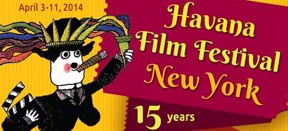
New York’s new Latin American cinema
NEW YORK – The Havana Film Festival New York, which this year marks its 15th birthday, is a unique event in this busy city, where every spring, along with the re-greening of the trees and the blooming of the flowers, a cinema festival seems to spring in every corner.
It is not just the quality of the film offer what makes the HFFNY bolder and more interesting than similar events but also its ability to make the American public break — albeit by extension — the anachronistic embargo imposed on Cuba for more than half a century, which forbids them to travel to the island and enjoy the renowned Havana International Festival of New Latin American Cinema.
“We work to build cultural bridges between the U.S. and Cuba through the arts,” says Carole Rosenberg, president of the American Friends of the Ludwig Foundation of Cuba, a nonprofit organization that created the New York festival in close cooperation with Havana’s festival, held in the Cuban capital for 30 years and more.
In its present edition, between April 3 and 11, the HFFNY offers a real lightning tour of the best of the new Latin American cinema, with 45 productions from 12 countries.
The public will be able to enjoy the latest in feature films, documentaries and shorts from Cuba, Argentina, Brazil, Chile, Colombia, Ecuador, the Dominican Republic, Spain, Guatemala, Panama, Puerto Rico and the United States, not forgetting the classic films from those countries.
It is a rare opportunity to see extraordinary movies that are almost never shown in this country.
“This year, the festival is devoted to the Cuban cinema and pays tribute to the ICAIC (Cuban Institute of Cinematographic Arts and Industry) for its 55 years of existence,” says Diana Vargas, the event’s artistic director. “Cuban cinema was a pioneer and the ICAIC produced marvelous movies that set trends for many years, at a time when Latin America produced very little cinema.”
The festival opens with the New York premiere of the formidable Cuban film “Conducta,” which has set a new box-office record on the island and has received enthusiastic reviews abroad since its premiere last month.
It will be followed by no fewer than 24 Cuban movies by outstanding directors, among them the little-known “Historias de la Revolución,” by Tomás GutiérrezAlea; “De Cierta Manera,” by Sara Gómez; “Now!” by Santiago Álvarez; “Retrato de La Habana,” by Humberto Solás, and “Hacerse el Sueco,” by Daniel Díaz Torres. They are the equivalent of a fascinating tour through 55 years of Cuban film-making.
The offerings from another countries — such as “El Doctor Alemán,” by Argentine director Lucía Puenzo, which will close the festival and will be shown commercially in New York movie houses — is no less important.
The brave documentary “Coro de Silencio,” by Roberto Rodríguez, a Cuban living in Puerto Rico, is an example of the variety and quality of the festival’s offerings. It focuses on the memories of sexual and psychological abuses committed by some clergymen and social workers upon many of the 14,000 Cuban children who were sent without their parents to the United States in the so-called Operation Peter Pan (1960-1962), organized by the CIA and the Diocese of Miami. It is a tragic and ignored story.
“No Robarás — a Menos que Sea Necesario,” a powerful feature film by young Ecuadorean director Viviana Cordero, is another film with a current theme. It tells the story of a 17-year-old girl who rebels against the fate of victim that so often befalls the Latin American woman.
In sum, the list of movies is long, valuable and bold.
Culturally and artistically, the Havana Film Festival New York is a huge success. But even more important is its contribution to friendship between Cuba and the United States.
“Art does not have political barriers,” Vargas says. “It can bring people together beyond any embargo.” For more information, access www.hffny.com.
Albor Ruiz is a freelance writer and journalist based in New York. You can reach him at albor.ruiz@aol.com.


